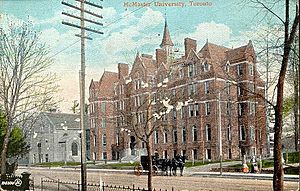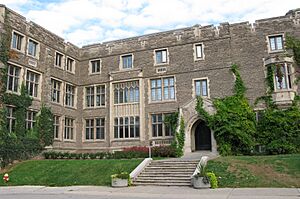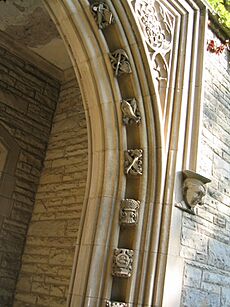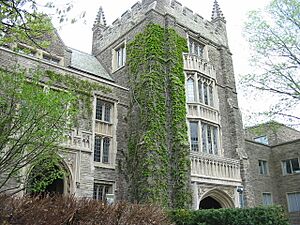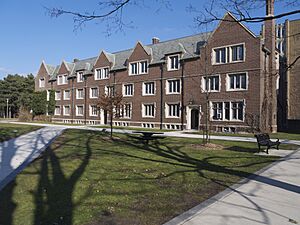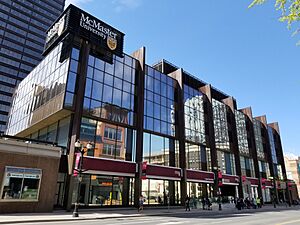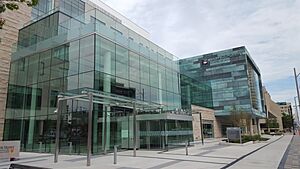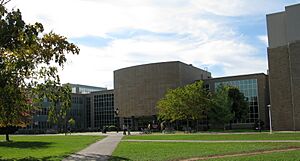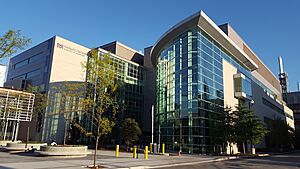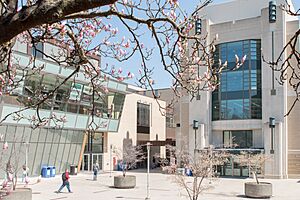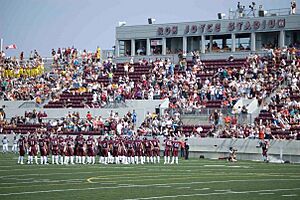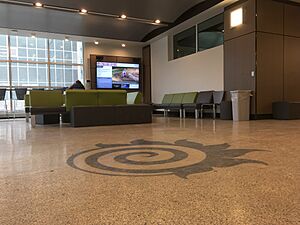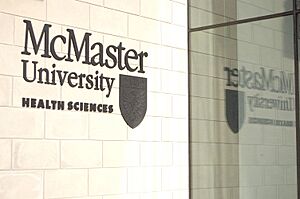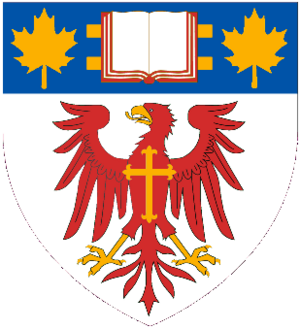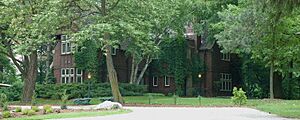McMaster University facts for kids
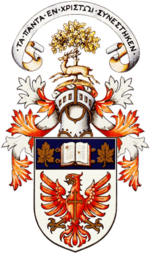
|
|
| Motto | Τὰ πάντα ἐν Χριστῷ συνέστηκεν (Greek) |
|---|---|
|
Motto in English
|
In Christ all things consist |
| Type | Public university |
| Established | 23 April 1887 |
| Affiliation |
|
| Endowment | CA$908.7 million |
| Chancellor | Santee Smith |
| President | Susan Tighe |
| Provost | Maureen J. MacDonald |
|
Academic staff
|
992 |
|
Administrative staff
|
12,786 |
| Students | 37,592 (2023-2024) |
| Undergraduates | 32,105 |
| Postgraduates | 5,487 |
| Location |
,
Canada
43°15′48″N 79°55′8″W / 43.26333°N 79.91889°W |
| Campus | Urban, 152.4 hectares (377 acres) |
| Colours |
|
| Nickname | Marauders |
|
Sporting affiliations
|
U Sports – OUA, CUFLA |
| Mascot | Mac the Marauder |
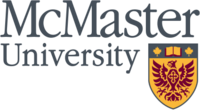 |
|
McMaster University is a well-known public research university in Hamilton, Ontario, Canada. People often call it McMaster or Mac. The main campus is a large area of land, about 152.4 hectares (377 acres), located near the beautiful Royal Botanical Gardens.
McMaster University has six main study areas, called faculties. These include business, engineering, health sciences, humanities, social sciences, and science. It is part of the U15, which is a group of top Canadian universities known for their research.
The university is named after William McMaster. He was an important Canadian senator and banker who left a lot of money to help start the university. It officially began in 1887 by combining two colleges. McMaster first opened in Toronto in 1890. Later, in 1930, it moved to Hamilton because it needed more space and received land there.
McMaster University started as a religious institution. However, in 1957, it became a public university that welcomes students of all backgrounds. As of the 2023-2024 school year, McMaster has over 32,000 undergraduate students and more than 5,000 graduate students. Its sports teams are called the Marauders. Many famous people have studied at McMaster, including government leaders, scientists, business owners, and even Nobel Prize winners.
Contents
A Look Back: McMaster's History
McMaster University grew from early education efforts by a group called Baptists in the 1830s. The university's first version was Toronto Baptist College, started in 1881. William McMaster, a Canadian senator and banker, left money to create a university. This led to Toronto Baptist College joining with Woodstock College's theology program. This merger officially happened in 1887, and the new school was named McMaster University.
The university first opened in Toronto in 1890, in a building called McMaster Hall. It was supported by the Baptist Convention of Ontario and Quebec. The first classes were in arts and theology, and the first degrees were given out in 1894.
As the university grew, McMaster Hall became too small. People started talking about moving the university to Hamilton. By the 1920s, the Hamilton Chamber of Commerce actively worked to bring McMaster to their city. In 1927, the university decided to make the move.
The Baptist Convention of Ontario and Quebec raised money, and the people of Hamilton also helped. Land for the new campus and buildings came from donations. The first classes at the new Hamilton campus began in 1930. McMaster's old property in Toronto was sold to the University of Toronto.
During the 1940s, there was a growing need for science and technology experts. This put a strain on the university's finances, as it was still a religious institution and couldn't get public money easily. To solve this, the university was reorganized in 1957. It became a public, non-religious institution, which meant it could receive government funding. The religious studies part became McMaster Divinity College, a separate but connected college. In 1957, McMaster also started building the McMaster Nuclear Reactor, which began operating in 1959. It was the first university-based research reactor in the Commonwealth.
In 1965, with help from the government, McMaster started a medical school and teaching hospital. The first doctors graduated in 1972. The university continued to grow and change its structure over the years, adding more faculties like Business and Engineering.
Exploring the Campus
McMaster University is in Hamilton, Ontario, a city in the Golden Horseshoe region near Lake Ontario. The main campus is next to Cootes Paradise, a large natural marshland. It is also close to residential areas and a main road. The northern parts of the campus are popular for walking trails that connect to the Royal Botanical Gardens.
The main campus covers about 152.4 hectares (377 acres). Most of the teaching buildings are in a smaller, central area of about 12.1 hectares (30 acres). McMaster also owns other properties in Hamilton and nearby cities like Burlington and Kitchener.
In 2017, the university had 58 buildings. These buildings range from the historic Hamilton Hall, opened in 1926, to newer centers. The campus is divided into three main parts: the Core Campus, North Campus, and West Campus. The Core Campus has most of the academic, research, and student housing buildings. The North Campus has sports facilities. The West Campus is less developed, with a few buildings and open land.
Buildings for Learning and Research
The university campus has been growing since 1928. The first six buildings on the main campus have a special style called Collegiate Gothic architecture. Today, more than fifty buildings surround them, mostly built from the 1940s to the 1960s.
One of the biggest facilities is the McMaster University Medical Centre. This is a hospital used for both research and teaching. It has one of the largest neonatal intensive care units and child mental health units in Canada. It connects to other buildings where scientists study genetics and infectious diseases.
The McMaster Nuclear Reactor (MNR) is the largest university reactor in the Commonwealth. It is also the second largest research reactor in North America. The MNR is mainly used for research and to make medical isotopes. These are special materials used in medicine. It also helps students learn about nuclear engineering and health physics. The university has other advanced tools like a cyclotron and an accelerator for research.
Libraries and Art Museum
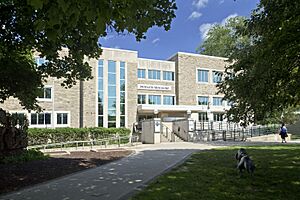
McMaster University has a large library system with four main libraries. These libraries hold over 1.2 million paper books and more than 3.6 million total resources, including videos, maps, and sound recordings. Mills Library focuses on humanities and social sciences. Innis Library supports business studies. Thode Library has science and engineering materials. The Health Science Library is for medical sciences.
The William Ready Division of Archives and Research Collections keeps important historical papers. These include writings from famous Canadian authors and the archives of Bertrand Russell, a well-known philosopher.
The McMaster Museum of Art (MMA) helps with the university's art studies. It is the most visited university museum in Canada, with 30,000 visitors in 2016. The museum has a collection of nearly 6,000 art pieces, valued at almost $99 million. This collection includes works by famous artists like Claude Monet and Vincent van Gogh. It also has a large collection of German expressionist prints.
Student Homes and Hangouts
McMaster has thirteen smoke-free student residences, which are buildings where students live. These residences can house 4,186 students. The newest residence, Peter George Centre for Living and Learning (PGCLL), opened in 2019. It can house 500 students and also has classrooms and places to eat. Les Prince Hall, another large residence, opened in 2006.
The residences offer different types of rooms, from traditional dorms to apartment-style living. Staff members called Residence Life staff help students adjust to university life.
The McMaster University Student Centre (MUSC) is a busy place for student activities. It has a café, study areas, and common spaces. Many student groups have their offices here, including the McMaster Students Union and the student newspaper, The Silhouette. The MUSC also has a health center and a dentist.
The university has over twenty places to eat on campus. McMaster has been recognized as one of Canada's most vegan-friendly universities.
Off-Campus Locations
McMaster University also has facilities outside its main campus. The DeGroote School of Business has a campus in Burlington. This building, called the Ron Joyce Centre, opened in 2010. It is home to the MBA program and other business courses.
The McMaster Centre for Continuing Education is in downtown Hamilton. It offers courses for adults who want to learn new skills or get certificates. McMaster also has the Downtown Health Campus in Hamilton. This center provides teaching spaces and health services for local residents.
The Michael G. DeGroote School of Medicine has two other campuses. One is in St. Catharines and the other in Kitchener. These campuses allow medical students to study in different parts of the region.
McMaster also bought a large industrial park near its main campus in 2005. This area, called the McMaster Innovation Park, is for research in advanced manufacturing, biotechnology, and nanotechnology. The United Nations University-International Network on Water, Environment and Health (UNU-INWEH) is also located here. It is the only United Nations agency based in Ontario.
Caring for Our Planet: Sustainability
McMaster University has an Office of Sustainability. This office works to make the university more environmentally friendly. McMaster signed an agreement in 2009 called Ontario Universities Committed to a Greener World. This shows its dedication to being a leader in environmental responsibility. The university also signed two agreements in 2010 to address climate change.
How McMaster is Run
McMaster University is governed by two main groups: the Board of Governors and the Senate. Both were created when the university was founded in 1887. The Board of Governors is in charge of the university's money, property, and overall management. The Senate is responsible for all academic matters. This includes setting rules for who can join the university and what is needed to earn degrees.
The President is the chief executive officer of the university. They oversee all the academic and administrative work. The current president, Susan Tighe, was appointed on July 1, 2025. She is McMaster's ninth president and the first engineer to hold this position.
McMaster Divinity College: A Special Connection
McMaster University has a special connection with McMaster Divinity College. This college is a seminary, which is a school for religious studies. It is located right on the university campus. While it has its own leaders, students in some of its programs receive their degrees from McMaster University. Students from both institutions can use each other's libraries.
The Divinity College was originally part of McMaster University. When McMaster became a public university in 1957, the Faculty of Theology became the separate McMaster Divinity College.
How McMaster Gets and Uses Money
As of June 6, 2024, McMaster University's total assets were about C$2,058.7 million. For the 2024–2025 school year, the university had revenues of C$1,400.3 million and expenses of C$1,367.7 million. This meant it had C$32.6 million more in revenue than expenses.
McMaster gets its money from various sources. These include tuition fees from students, donations, and annual grants from the city, province, and federal government. In the 2024-25 academic year, student tuition fees were the largest source of income. A big part of the money received from donations, about 40 percent, goes towards scholarships and bursaries for students.
What Students Learn: Academics at McMaster
| Faculties | Established |
|---|---|
| DeGroote School of Business | 1952 |
| Faculty of Engineering | 1958 |
| Faculty of Health Sciences | 1974 |
| Faculty of Humanities | 1887 |
| Faculty of Science | 1887 |
| Faculty of Social Sciences | 1887 |
McMaster is a public research university and a member of Universities Canada. It uses a semester system, with classes running year-round. In the 2023-2024 school year, there were 37,592 students in total. This included 32,105 undergraduate students and 5,487 graduate students.
The university's programs are organized into six faculties:
- DeGroote School of Business
- Faculty of Engineering
- Faculty of Health Sciences
- Faculty of Humanities
- Faculty of Science
- Faculty of Social Sciences
The Faculty of Science had the most students in September 2016. The Faculty of Humanities was the smallest. Many students also take part in programs that combine studies from two or more faculties. For example, the Arts and Science program offers a broad education in both arts and sciences.
McMaster also works with Mohawk College on several programs. The university gives degrees to graduate students from McMaster Divinity College.
Students can get financial help like loans and grants from the government. In the 2016–2017 school year, McMaster students received over C$140 million in loans and grants. They also received over C$10 million in bursaries. McMaster has exchange agreements with over 100 universities worldwide, allowing students to study abroad.
The McMaster Model: A Unique Way to Learn
The McMaster Model is a special way of teaching and learning. It focuses on students, solving problems, and combining different subjects. In the 1960s, the McMaster University Medical School started using "problem-based learning" (PBL). In PBL, students work in small groups to solve real-world problems, which helps them learn deeply. This method has been adopted by other parts of the university and by many medical schools around the world.
McMaster's medical school also developed a unique way to test students called the "personal progress index" (PPI). This system checks how much knowledge students gain and remember over time. It helps students see their progress and get feedback. The PPI is now used by medical schools in many countries.
McMaster's Place in University Rankings
| University rankings | |
|---|---|
| Global rankings | |
| ARWU World | 101–150 |
| QS World | =173 |
| Times World | =116 |
| U.S News & World Report Global | =127 |
| Canadian rankings | |
| ARWU National | 4–5 |
| QS National | 8 |
| Times National | =4 |
| U.S News & World Report National | 4 |
| Maclean's Medical/Doctoral | 4 |
McMaster University is recognized as one of the top universities in Canada and around the world. In the 2022 Academic Ranking of World Universities, it was ranked among the top 100 universities globally and fourth in Canada. The 2024 QS World University Rankings placed McMaster 189th in the world and sixth in Canada. The Times Higher Education World University Rankings for 2024 ranked McMaster 103rd globally and fourth in Canada.
McMaster is also known for its graduates' job prospects. In 2022, QS ranked McMaster 81st globally for graduate employability. Times Higher Education also placed McMaster 81st in the world for graduate employability in 2022.
Many of McMaster's health science programs are ranked very highly. For example, Clinical Medicine was ranked 2nd in Canada and 17th globally in 2024.
Amazing Discoveries: Research at McMaster
McMaster is known as a very research-focused university. In 2018, it was named the most research-intensive university in Canada. This means its professors receive a lot of funding for their research. In 2017, McMaster received over $379 million for research. The Canadian government provides a large part of this funding.
McMaster is especially strong in health sciences research. The Faculty of Health Science manages $130 million in research each year. The university even has a brain bank, which includes a part of Albert Einstein's brain for medical research! Researchers there have found differences in his brain that might be linked to his amazing thinking skills.
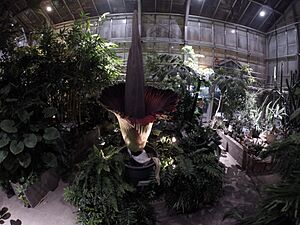
Other research centers at McMaster include the Origins Institute and the Brockhouse Institute for Materials Research (BIMR). BIMR has facilities like the Canadian Centre for Electron Microscopy, which houses the world's most powerful electron microscope. This microscope can magnify things 14 million times and is used for studying materials, medicine, and nanotechnology.
The Biology Greenhouse has 217 plants and is used for teaching and research. In 2024, a new, larger greenhouse with over 200 plant species was opened.
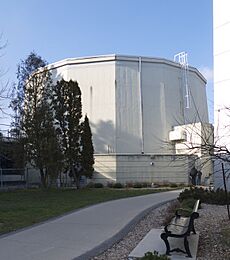
The McMaster Nuclear Reactor has been used for nuclear science and engineering research since 1959. It is a "swimming pool reactor" that helps make medical radioisotopes. These are special materials used in medicine, like iodine-125 for treating prostate cancer. McMaster produces 60 percent of the world's supply of iodine-125.
How to Get In: Admissions
The requirements for getting into McMaster can be different for students from Ontario, other parts of Canada, and international students. In 2021, about 61 percent of students who applied for full-time, first-year undergraduate programs were accepted. In September 2014, the average high school grade for first-year students was 87.7 percent. In 2023, the university received 47,544 applications.
Some programs at McMaster are very competitive. For example, the Honours Health Sciences Program is one of the hardest Canadian undergraduate programs to get into. In 2016, its acceptance rate was only 4.5 percent.
The Michael DeGroote School of Medicine developed special admission tests. In 2001, they created the "Multiple Mini Interview" (MMI). This uses short, timed interviews to check skills like teamwork, ethics, and critical thinking. Many medical schools in Canada and the U.S. now use the MMI. In 2010, the medical school also developed the "Computer-based Assessment for Sampling Personal Characteristics" (CASPer) test. This helps assess an applicant's personality traits. Other medical schools have also adopted the CASPer test.
Life as a McMaster Student
| Undergraduate | Graduate | |
|---|---|---|
| Male | 45.7% | 48.4% |
| Female | 54.3% | 51.6% |
| Canadian student | 90.8% | 76.6% |
| International student | 9.2% | 23.4% |
In the 2023–2024 school year, McMaster had 37,592 students. Most of these students were Canadian. About 92% of first-year students continue their studies at McMaster.
Student Groups and Activities
Students at McMaster have many ways to get involved. The McMaster Students Union represents full-time undergraduate students. There are also groups for part-time students and graduate students. Each faculty has its own student council.
McMaster has over 300 student organizations and clubs. These cover many interests, like academics, culture, religion, social issues, and sports. Many clubs are based at the McMaster University Student Centre. The Silhouette, the student newspaper, has been published since 1929. CFMU-FM (93.3 FM) is the university's radio station, broadcasting since 1978.
The university also has groups like the McMaster Improv Team for comedy and the McMaster Artificial Intelligence Society (Mac AI). Mac AI became one of the largest student-run AI clubs in the world.
McMaster hosts honor societies, such as the McMaster Honour Society. There are also two acting companies, McMaster Musical Theatre and the McMaster Thespian Company. The McMaster Engineering Musical is an annual show created by engineering students.
McMaster Sports: The Marauders
Sports at McMaster are managed by the athletics and recreation department. The university's varsity teams are called the McMaster Marauders. They compete in the Ontario University Athletics conference, which is part of U Sports (Canada's national university sports organization).
McMaster has teams in many sports, including baseball, basketball, football, lacrosse, rugby, soccer, swimming, volleyball, and water polo. The first major sports game at McMaster was in 1889. The name "Marauders" for the teams was chosen in 1948 through a student newspaper contest. In the 2016–2017 school year, over 1,100 students were part of varsity or club teams.
The Marauders have won 11 national championships and 139 provincial championships since 1961. The men's water polo team has won the provincial championship 25 times. The men's wrestling team has won the national championship four times. Many McMaster graduates have become Olympic athletes, coaches, and officials.
The university's sports facilities are in the northeast part of the campus. These include the David Braley Athletic Centre and the Ron Joyce Stadium. Ron Joyce Stadium has seating for 6,000 people and a full-sized football and soccer field. It is also used by the Hamilton Tiger-Cats football team for training.
McMaster also has many intramural sports leagues and tournaments. These allow students of all skill levels to play sports like volleyball, basketball, soccer, and even unique games like dodgeball and inner tube water polo.
Symbols of McMaster University
McMaster University uses several symbols to represent itself. The university's logo was approved in 1997. Other symbols include a flag, unveiled in 2015, and a ceremonial mace. The mace was given to the university in 1950. It is used in ceremonies like graduation and symbolizes the university's power to give out degrees. The university also uses the slogan "Learning Without Borders."
Individual departments and faculties also have their own symbols. For example, the Faculty of Engineering uses a fireball emblem, which it adopted in 1960.
Motto and Songs
The university's motto is in Greek: ΤΑ ΠΑΝΤΑ ΕΝ ΧΡΙΣΤΩΙ ΣΥΝΕΣΤΗΚΕΝ. This means "In Christ all things consist." The motto was chosen in 1888. It is unusual because it uses Greek instead of Latin, which is more common for university mottos. McMaster's founders wanted to connect to the earliest days of Christianity.
McMaster has several songs that are played at events like graduation and sports games. These include "The Alma Mater Song," "Shout for McMaster! (The McMaster March)," and "My Mac." "Shout for McMaster!" is the university's official fight song.
The Coat of Arms
After moving to Hamilton in 1930, McMaster University received its coat of arms from Scotland. This happened on October 20, 1930. In 1997, a simpler design of the shield was introduced. The university's coat of arms was officially registered in Canada in 2006.
The coat of arms has a shield, a crest, and the motto. The shield shows an eagle, which represents heavenly vision. A cross on the eagle's chest shows that Christianity inspired the university. At the top of the shield, there is an open book, a common symbol for learning. Two golden maple leaves on either side of the book represent that the university was founded in Ontario, Canada.
The helmet above the shield is a style often used by universities. The fabric around the shield and helmet looks like a knight's cloak. The crest, above the helmet, shows a stag (a male deer) and an oak tree. This honors William McMaster, who also used a stag and oak in his own symbols. The motto is placed above the crest, as is common in Scottish coats of arms.
Famous People from McMaster
-
Tihomir Orešković, who was the 11th Prime Minister of Croatia.
-
Tommy Douglas, the 7th Premier of Saskatchewan and first leader of the NDP.
-
Bertram Brockhouse, a Nobel laureate in physics for his work with neutron scattering.
-
Donna Strickland, a Nobel laureate in physics for her work with laser physics.
-
Myron Scholes, a Nobel laureate in economics for his work with the Black–Scholes model.
-
Stephen Elop, a former president and chief executive officer of the Nokia Corporation.
-
Cyrus S. Eaton, who founded Republic Steel and was chairman of C&O Railway.
As of 2016, over 184,000 people who studied at McMaster University live in more than 139 countries. Many of these alumni and faculty members have become very successful in different fields. They have won many awards, including Nobel Prizes, Rhodes scholarships, and the Gates Cambridge Scholarship.
Some Nobel Prize winners from McMaster include:
- Myron Scholes, who won the Nobel Memorial Prize in Economic Sciences in 1997.
- Bertram Brockhouse, a faculty member who won the Nobel Prize in Physics in 1994.
- Donna Strickland, an alumna who won the Nobel Prize in Physics in 2018.
- James Orbinski, an alumnus who accepted the Nobel Peace Prize in 1992 on behalf of Doctors Without Borders.
In science, notable alumni include Douglas L. Coleman, who discovered leptin, and Harold E. Johns, who helped pioneer the use of cobalt-60 for cancer treatment. Two medical researchers from McMaster, Dafydd Williams and Roberta Bondar, have even traveled to space! Roberta Bondar was the first Canadian woman in space.
Many former students have become important government leaders. Tihomir Orešković was the Prime Minister of Croatia. Lincoln Alexander was the first visible-minority Lieutenant Governor of Ontario. Canadian premiers like Dalton McGuinty (Ontario) and Tommy Douglas (Saskatchewan) also graduated from McMaster.
In the business world, McMaster alumni include Stephen Elop, a former CEO of Nokia, and Paul D. House, chairman of Tim Hortons.
McMaster alumni have also had successful careers in sports, like Syl Apps of the Toronto Maple Leafs, and Olympic medalists Larry Cain and Adam van Koeverden. In entertainment, famous alumni include comedians and actors like Eugene Levy, Martin Short, and Ivan Reitman. Max Kerman from the Canadian rock band Arkells also studied at McMaster.
See also
 In Spanish: Universidad McMaster para niños
In Spanish: Universidad McMaster para niños


